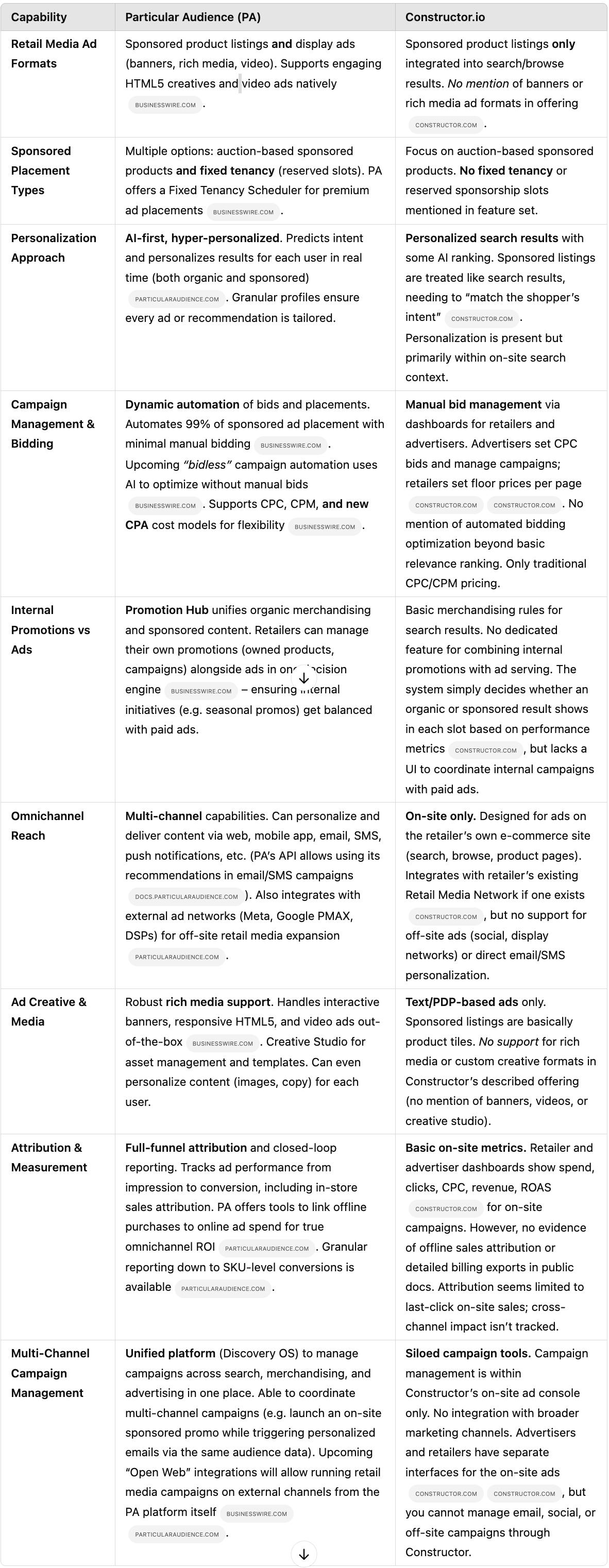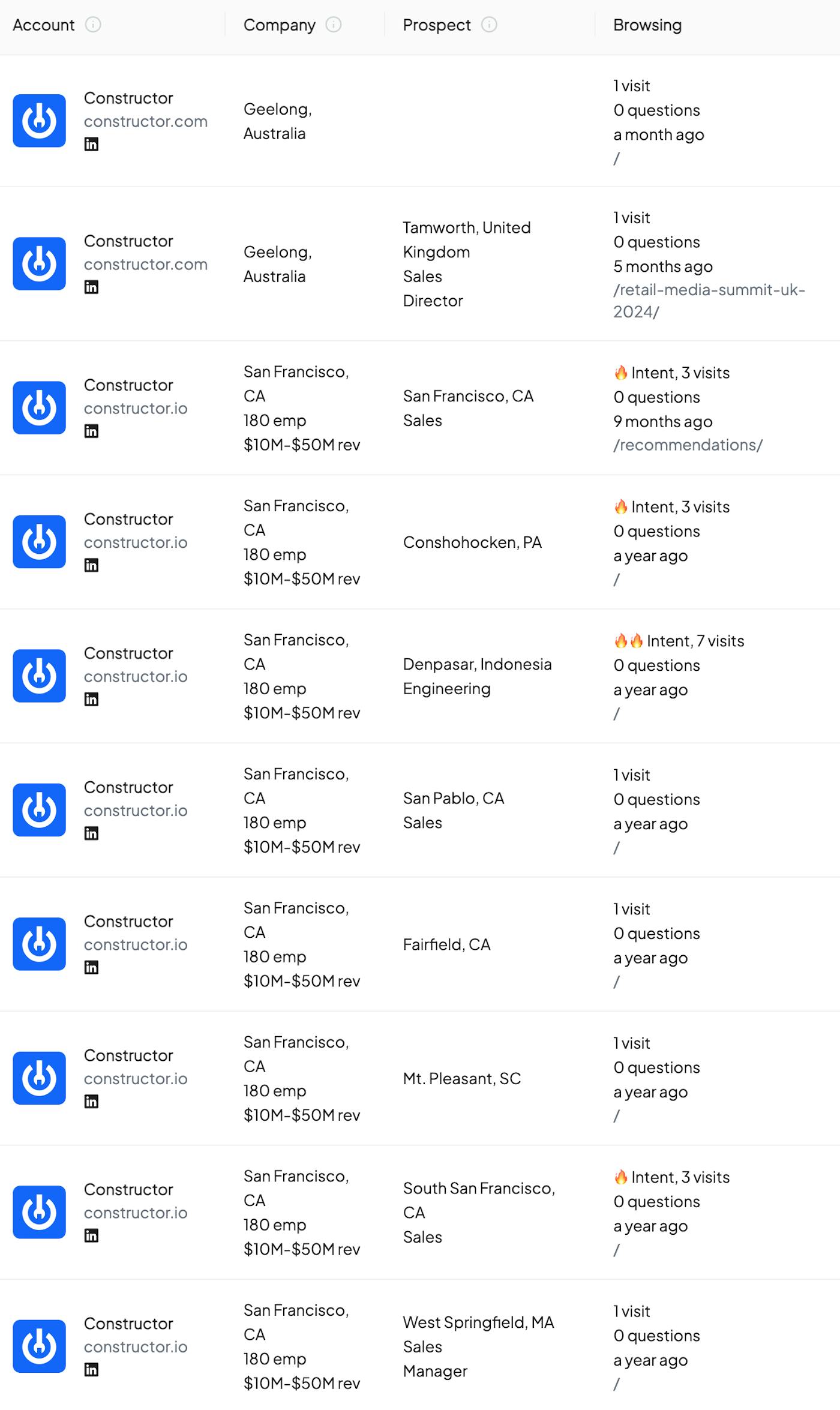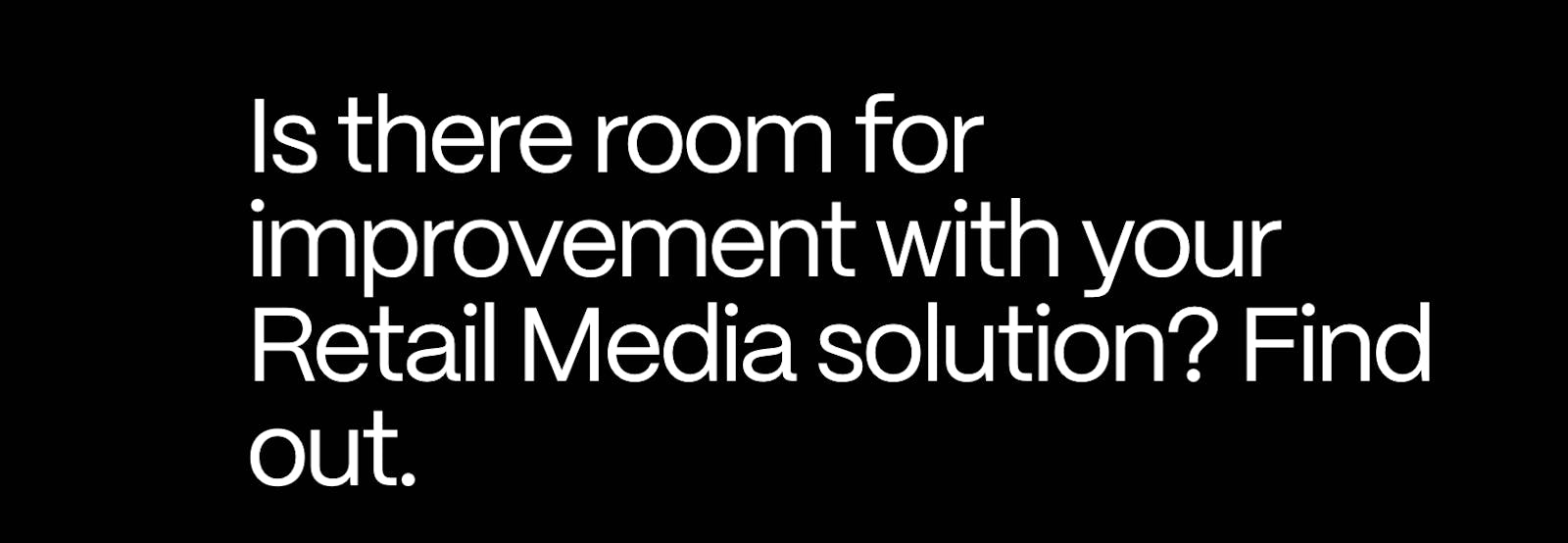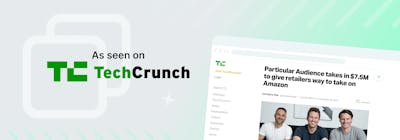This article is an unedited summary generated by ChatGPT and is not advertising or an endorsement. The content has not been independently verified and may contain inaccuracies, outdated information, or incomplete comparisons. Particular Audience does not verify or adopt the views expressed. Readers should consult official sources before relying on this information.
Looking for a Constructor.io Alternative?
Retailers today are rapidly expanding their retail media and onsite personalization efforts to drive new revenue. Retail media is booming – in fact, retail media search ad spend grew 22% in 2025 compared to just 8% growth in traditional search ads (Introducing Constructor's Retail Media Suite). With this surge, many retailers are seeking a robust platform to monetize their ecommerce traffic without compromising the shopper experience. Constructor.io has made a name in product discovery and recently launched a Retail Media Suite. However, forward-thinking retailers often look for a more comprehensive Constructor alternative – one that goes beyond basic sponsored listings. This is where Particular Audience (PA) comes in.
Why Particular Audience Leads in Retail Media & Personalization
In this article, we’ll provide an unbiased yet in-depth comparison of Constructor.io vs. Particular Audience. We’ll examine each platform’s capabilities in retail media, onsite search personalization, and ecommerce advertising, and highlight why Particular Audience stands out as the superior choice for retailers building their own retail media networks. By the end, you’ll understand the key differences and unique advantages of PA’s retail media platform – from rich media ads and dynamic AI automation to full-funnel attribution – and why it’s a compelling Constructor.io alternative for your business. Let’s dive in.
Constructor.io vs. Particular Audience: Feature Comparison
Both Constructor.io and Particular Audience aim to help retailers turn their ecommerce sites into revenue-generating retail media networks. They integrate advertising into onsite search and discovery so retailers can earn ad income from brand partners (without ruining the user experience). At a glance, however, the two platforms have very different approaches and feature sets.
Constructor.io is primarily known for its AI-driven search and product discovery. Its new retail media offering focuses on on-site sponsored product listings integrated with search results. As Constructor puts it, their Retail Media Suite includes “Sponsored Listings and Retail Media Partner integrations” to help retailers “unlock ad revenue without sacrificing shopper trust by optimizing organic and paid listings in the same engine” (Introducing Constructor's Retail Media Suite). In other words, Constructor’s solution inserts paid product ads into search and category pages, balancing them with organic results so they feel native to the shopping journey.
Particular Audience, on the other hand, was built from the ground up as a unified retail media and personalization platform. PA combines organic product discovery (search, recommendations) and sponsored content in one AI-driven system (How Retailers Can Win: Navigating the eCommerce & Retail Media Technology Maze). It goes beyond just search ads – enabling various ad formats (including rich media), multi-channel personalization, and advanced optimization. PA’s CEO emphasizes that PA “isn’t just another retail media platform – it’s an AI company at its core. Every ad and recommendation should be hyper-personalized in real time. That’s what we’re delivering.” (Particular Audience Announces Largest Ever Product Release—Reinforcing Market Leadership in Advanced AI-Powered Retail Media, Search & Personalization) This reflects PA’s philosophy of using AI to predict shopper intent and serve the most relevant content across all touchpoints, not just search pages.
So how do Constructor vs. Particular Audience stack up on key capabilities? The table below provides a side-by-side comparison of the features that matter most for a retail media platform and onsite search personalization solution:

Table: Side-by-side comparison of Particular Audience vs. Constructor.io across key retail media network software features.
As the comparison shows, Particular Audience offers a far more extensive toolkit for retail media and personalization. Next, we’ll dive deeper into PA’s unique advantages and how they address retailers’ needs beyond what Constructor provides.
Unique Advantages of Particular Audience for Retail Media & Personalization
Choosing a retail media platform is a strategic decision. Let’s examine the standout benefits of Particular Audience in detail, and why these capabilities matter for retailers looking to build a successful retail media program:
1. Promotion Hub – Balancing Internal Campaigns with Sponsored Content
One of PA’s most innovative features is its Promotion Hub. This gives retailers a unified control center to manage organic merchandising, owned promotions, and sponsored ads together. In practice, that means you can coordinate your in-house marketing initiatives (such as promoting a private-label brand or a clearance sale) right alongside paid sponsor placements. According to PA’s release, Promotion Hub provides “a unified view for retailers to manage organic, owned, and sponsored product discovery in one decision engine” (Particular Audience Announces Largest Ever Product Release—Reinforcing Market Leadership in Advanced AI-Powered Retail Media, Search & Personalization).
Why is this important? Many retailers struggle to juggle revenue from ads with their own strategic promotions. Constructor’s approach simply mixes ads with organic results based on predicted performance, but it lacks a concept of “owned” campaigns. PA’s Promotion Hub ensures your priorities (e.g. featuring a new collection or meeting a supplier co-op commitment) can be blended with sponsored ads in a rational way. You can set rules or objectives so that internal campaigns and paid ads complement each other, rather than internal promos getting inadvertently buried by the highest bidder. This balance helps retailers maximize ad revenue and achieve merchandising goals simultaneously – a win-win that a basic sponsored listings tool can’t easily deliver.
2. AI-Powered Dynamic Bid Automation
Another major advantage of Particular Audience is its focus on automating campaign optimization. Traditional retail media (and Constructor’s model) often requires manual bidding and lots of tweaking to get results. PA takes a different approach: its platform uses AI to handle bidding and placement decisions dynamically, in real time. In fact, PA’s latest release introduced an AI-Powered Sponsored Search module that automates sponsored product placements across “99% of search results, eliminating manual keyword bidding” (Particular Audience Announces Largest Ever Product Release—Reinforcing Market Leadership in Advanced AI-Powered Retail Media, Search & Personalization). This means the system itself figures out which ads to show for each query and how much to bid, based on likely conversion and revenue uplift.
The result is far less manual work for ad managers and far more efficient outcomes. PA is even pioneering “bidless” campaign automation (Particular Audience Announces Largest Ever Product Release—Reinforcing Market Leadership in Advanced AI-Powered Retail Media, Search & Personalization), where the platform optimizes ad delivery without requiring fixed bids at all – similar to how Meta’s Advantage+ or Google’s Performance Max automates ad targeting and budgeting. (Notably, PA’s CEO predicts that “manual targeting in Retail Media will be obsolete” in a few years, just as Meta’s AI-driven tools have replaced old manual workflows (Particular Audience Announces Largest Ever Product Release—Reinforcing Market Leadership in Advanced AI-Powered Retail Media, Search & Personalization).) By contrast, Constructor’s offering involves setting cost-per-click bids and managing budgets in a self-service dashboard (Ecommerce Retail Media | Constructor). While Constructor’s system does auto-balance ads vs. organics, it doesn’t claim to auto-optimize bids for you. PA’s dynamic bid automation can significantly improve performance by continually learning and adjusting, and it frees your team from constant micromanagement of keywords and bids.
3. Rich Media Ads and Multi-Channel Reach
When it comes to ad formats and channels, Particular Audience opens up many more possibilities than Constructor. PA supports a variety of rich media and display ad formats in addition to sponsored product listings. Retailers can serve banner ads, interactive HTML5 content, and even video ads on their e-commerce sites through PA (Particular Audience Announces Largest Ever Product Release—Reinforcing Market Leadership in Advanced AI-Powered Retail Media, Search & Personalization). For example, a brand could run a shoppable video spotlighting a product, or a visually striking carousel banner – all managed within PA’s platform. These creative options help retail media feel more like a premium experience (and unlock higher CPMs from advertisers). Constructor’s Retail Media Suite has no mention of display or rich media capabilities – it is limited to product listing ads that look like search results (Introducing Constructor's Retail Media Suite). If a retailer wants to sell homepage banner ads or interactive promos, that’s not something Constructor offers out-of-the-box.
Moreover, Particular Audience extends personalization beyond the website. Its platform can leverage the same customer data and product recommendations to personalize emails, SMS messages, and push notifications. For instance, PA’s API can be used to insert personalized product recommendations into your email or SMS campaigns (Quick Start: Recommendations | Particular Audience). This means the marketing team can orchestrate a consistent campaign – showing a shopper a sponsored product on the site, and then reminding them via a follow-up personalized email or app notification. Such cross-channel orchestration is invaluable for increasing conversion. Constructor.io’s solution has no cross-channel messaging component; it’s entirely focused on on-site interactions.
PA also integrates with external ad networks and channels. Retailers can connect PA with platforms like Meta (Facebook/Instagram ads), Google Ads (Shopping, Performance Max), or open web DSPs (Innovative Retail Media Applications of Particular Audience APIs). This capability allows retailers to manage off-site advertising for their retail media clients using first-party data. For example, a brand could extend a campaign to show ads on social media to users who viewed its products on the retailer’s site. PA consolidates the performance data from these off-site campaigns as well. In short, Particular Audience acts as a true retail media network software, spanning on-site and off-site ads. Constructor’s platform does integrate with “retail media partner” networks (Introducing Constructor's Retail Media Suite) (meaning if a retailer already has an external ad network, Constructor can mediate on-site inventory with it). But Constructor doesn’t itself facilitate creating new off-site campaigns; PA does, giving retailers far more omnichannel reach.
4. Full-Funnel Attribution and Omni-Channel Insights
With retail media becoming more sophisticated, advertisers expect to see the full-funnel impact of their spend – not just last-click web sales, but also brand lift and offline sales. This is another area where PA shines. Particular Audience provides robust attribution tools that link ad impressions to sales across channels, including in-store purchases. A PA technical whitepaper highlights “enhancing omnichannel attribution by linking in-store and online sales to digital ad spend” as a core capability (Innovative Retail Media Applications of Particular Audience APIs). In practice, if a shopper sees a sponsored product on the website and later buys that item in a physical store (using a loyalty ID, for example), PA can attribute that offline sale back to the ad exposure. This closed-loop reporting gives retailers and brands a true picture of ROI. PA’s platform can also optimize campaigns using these insights – for example, adjusting bids for campaigns that drive not just online clicks but also store visits or larger basket sizes.
Constructor.io’s documentation, on the other hand, focuses on on-site metrics like clicks, CPC, and ROAS for the sponsored listings (Ecommerce Retail Media | Constructor). There’s no evidence that Constructor supports offline attribution or multi-touch attribution. If an ad influenced a store sale or contributed to a purchase later via another channel, Constructor wouldn’t capture that in its standard reports (at least not as publicly described). This is a significant gap for retailers who operate both online and brick-and-mortar, or who run broader marketing campaigns. With PA, the retail media program can truly be measured in the context of omni-channel retail success. Retailers get dashboards that combine on-site and off-site performance, giving a holistic view of how ads drive revenue across e-commerce and stores. That level of insight not only proves the value of the retail media network to brand partners, but also helps in optimizing media budgets across the funnel (e.g. shifting spend to the tactics that yield the most total sales (Innovative Retail Media Applications of Particular Audience APIs)).
5. More Granular and Dynamic Personalization
Both Constructor and Particular Audience use personalization to make ads more relevant, but PA takes it to the next level. Personalization isn’t a checkbox feature for PA – it’s the foundation of the entire platform. PA’s algorithms build extensive shopper profiles and use machine learning to deliver “hyper-personalized experiences at scale,” predicting what each shopper is likely to want (How Retailers Can Win: Navigating the eCommerce & Retail Media Technology Maze). This applies not only to product recommendations but also to which sponsored products or offers to show, and even how to tailor content. As noted in a PA case study, the platform can even adapt content like images or messaging to each user segment in real time (How Retailers Can Win: Navigating the eCommerce & Retail Media Technology Maze). If two users search for the same term, they might see different sponsored results or banners, based on their behavior and preferences.
Constructor.io does incorporate personalization in the sense that its sponsored listings are ranked in part by user behavior and relevance. They state that a sponsored result “has to match the shopper’s intent” and won’t be shown if it’s not likely to beat the organic result (Introducing Constructor's Retail Media Suite). This protects the experience but it’s a relatively coarse personalization (show ad vs not show ad). It doesn’t mean Constructor is doing one-to-one predictive targeting beyond the context of the search query. PA’s personalization is more granular – it layers user affinity data, context, and even creative optimization. For example, PA can personalize which promotion to show a user (a discount vs a new arrival, etc.) based on what will resonate best, in addition to choosing the best product ad. This dynamic, AI-driven personalization leads to higher engagement. In fact, Particular Audience reports significantly higher click-through rates on its AI-personalized recommendations and ads (1.1% CTR vs ~0.39% industry average, a 182% improvement) (How Retailers Can Win: Navigating the eCommerce & Retail Media Technology Maze). Such stats underline that PA’s deeper personalization drives real performance gains. Retailers looking for a platform that will continually learn and refine the experience for each customer will find PA is built for that level of sophistication, whereas Constructor is more narrowly focused on making sure sponsored products don’t degrade the experience.
6. Multi-Channel Campaign Management and Flexibility
Lastly, Particular Audience offers a more flexible, all-in-one management interface for retail media and personalization campaigns. Through PA’s Discovery OS console, a retailer’s ecommerce team can manage search optimization, product recommendations rules, promotional campaigns, and advertising all in one place. Additionally, they can manage campaigns that span multiple channels (onsite, email, offsite ads) from this unified platform. For example, you could create a campaign for a brand partner that includes a homepage banner, a sponsored product slot on the search page, and a personalized follow-up email campaign – all coordinated within PA. This multi-channel campaign capability is enhanced by PA’s upcoming “Open Web Demand Integrations,” which will let retailers place ads on external properties using PA (Innovative Retail Media Applications of Particular Audience APIs). It essentially blurs the line between your on-site promotions and external digital marketing, allowing you to run a true retail media network that reaches shoppers wherever they are.
Constructor.io’s environment is more limited in scope. They do provide nice tools for on-site campaign management – for instance, a retailer-side dashboard (SSP) and an advertiser-side dashboard (DSP) to manage sponsored listings campaigns (Ecommerce Retail Media | Constructor) (Ecommerce Retail Media | Constructor). For some retailers, this covers the basics: you can invite brands to bid on placements and they can log in to see their ad performance. However, you’ll be using separate systems for any other marketing or advertising channels. If your marketing team wants to coordinate an email promotion or a Facebook retargeting ad with the on-site sponsored products, they’ll have to do so outside of Constructor’s system. There’s also no built-in support for creative asset management or multi-format campaigns in Constructor’s retail media tool – it’s strictly about product listings. Particular Audience’s platform, in contrast, has features like a Creative Studio for managing rich media assets (Particular Audience Announces Largest Ever Product Release—Reinforcing Market Leadership in Advanced AI-Powered Retail Media, Search & Personalization) and a Notification Center for workflow approvals (Particular Audience Announces Largest Ever Product Release—Reinforcing Market Leadership in Advanced AI-Powered Retail Media, Search & Personalization), reflecting a more mature toolset for campaign execution. This means PA can serve as the central hub for all your e-commerce personalization and advertising efforts, reducing silos between different tools and teams.
Gaps in Constructor.io’s Retail Media Offering
To be fair and thorough, let’s summarize some limitations of Constructor.io’s retail media suite that often drive retailers to explore alternatives like Particular Audience:
- No Support for Display or Rich Media Ads: Constructor’s solution focuses solely on sponsored product listings that appear within search or category results. Nowhere in its launch announcements or documentation is there any mention of banner ads, rich media, or interactive creatives. Their own description emphasizes “Sponsored Listings… integrated with organic results” (Introducing Constructor's Retail Media Suite), indicating a lack of on-site display advertising options. Retailers who want to offer high-impact placements like homepage takeovers, videos, or custom content ads will find Constructor lacking in this area.
- No Fixed Tenancy/Sponsorship Deals: Many retailers monetize via fixed tenancy ads – e.g. selling a top spot on the homepage for a week at a fixed fee, or guaranteeing a brand 100% share-of-voice for a category page for a day. Constructor’s Retail Media Suite doesn’t appear to support this kind of scheduled, guaranteed placement. It’s built around algorithmic insertion of ads based on relevance and bidding. Particular Audience explicitly introduced a Fixed Tenancy Scheduler to enable premium sponsorship types (Particular Audience Announces Largest Ever Product Release—Reinforcing Market Leadership in Advanced AI-Powered Retail Media, Search & Personalization), but Constructor provides no evidence of a similar feature. This gap means Constructor might only accommodate pay-per-click campaigns, not the full variety of retail media deals that retailers may want to offer their brand partners.
- Limited Billing and Attribution Features: For a retail media program to scale, you need robust billing, reporting, and attribution. Constructor gives basic metrics in its dashboards (spend, CPC, ROAS, etc. (Ecommerce Retail Media | Constructor)), but it’s unclear if it offers things like automated billing exports for invoicing brands, or multi-touch attribution reports. The absence of any mention of attribution modeling or offline/omnichannel tracking suggests those are not part of the package. By contrast, PA emphasizes closed-loop attribution (tying ads to in-store sales and overall customer impact) (Innovative Retail Media Applications of Particular Audience APIs). If proving the incremental value of your retail media network to advertisers is important, Constructor may fall short with its out-of-the-box analytics.
- No Personalized Content or Cross-Channel Orchestration: Beyond product ads, modern personalization engines can also deliver tailored content (like personalized banners or dynamic content slots on a page) and coordinate messaging across channels. Constructor.io’s offering does not extend into personalized content placements – for example, it won’t dynamically swap out a hero image based on user data, since it’s not a content personalization platform. It also doesn’t have integrations to trigger emails or push notifications as part of a campaign. Essentially, Constructor is confined to the on-site experience, whereas Particular Audience can personalize every touchpoint (site, email, SMS) in a campaign. Retailers looking for cross-channel orchestration – using the website, mobile app, and marketing channels in concert – would need additional tools alongside Constructor. PA provides those capabilities in a unified way, reducing the need for multiple vendors.
It’s worth noting that Constructor.io is a strong player in product search and discovery, and its retail media addition is relatively new. It may be sufficient for retailers who only want a basic on-site sponsored product program tightly tied to search results. However, the above gaps are significant for enterprise retailers aiming to build a full-fledged retail media network with diverse ad offerings and advanced personalization.
Conclusion: Why Particular Audience Is the Superior Choice
When evaluating Constructor.io vs. Particular Audience as platforms for retail media, onsite search, and personalization, the differences become clear. Constructor.io provides a solid foundation for sponsored product ads within your site search – useful for basic monetization without hurting the UX. But Particular Audience offers a far more expansive solution that aligns with where retail media is headed: AI-driven, personalized, omnichannel, and rich with features that drive incremental revenue.
Particular Audience combines what retailers need for retail media, search, and personalization in one place. It brings capabilities like rich media and multi-channel outreach that Constructor lacks, while also delivering a cutting-edge AI approach to search and recommendations (a domain where Constructor has traditionally competed, but PA has matched and arguably leapfrogged with innovations like its Adaptive Transformer Search). Even VentureBeat took notice of PA’s rapid innovation – covering Particular Audience’s “largest ever product release” that “reinforces [its] market leadership in advanced AI-powered retail media, search & personalization” (Particular Audience Announces Largest Ever Product Release—Reinforcing Market Leadership in Advanced AI-Powered Retail Media, Search & Personalization). This kind of industry validation underlines that PA is setting the pace in this space.
For retailers, choosing PA means choosing a platform that can grow with your ambitions. You’re not just getting an ad server for your website – you’re getting an AI partner that can personalize shopper journeys end-to-end, an advertising engine that maximizes yield automatically, and a holistic campaign hub that connects on-site and off-site marketing. By contrast, sticking with a narrower toolset could mean missed opportunities (in ad revenue, in customer engagement, or both).
In summary, if you’re searching for a Constructor alternative that can power a modern, high-growth retail media program, Particular Audience is a superior choice. It offers more channels, more formats, deeper personalization, and smarter automation – all crucial for staying competitive in the evolving world of ecommerce advertising. Don’t just take our word for it; the features and facts we’ve outlined are backed by the platforms’ own claims and industry reports.
Ultimately, the best way to appreciate the difference is to see it in action. Ready to elevate your retail media and personalization strategy? Consider scheduling a demo of Particular Audience’s platform. With PA’s rich capabilities, retailers have reported multiple times ROI uplift and new revenue streams unlocked – all while keeping shoppers happier with genuinely relevant experiences.
Discover what a truly AI-driven retail media network platform can do for your business. Request a demo of Particular Audience today, and position your retail media network for future growth.
We Look Forward to Continuing to Inspire Constructor's Product Roadmap

Looking to Launch or Improve Your Retail Media Network?
Get in touch with us to get help in understanding a holistic overview of all requirements you should be looking for from a Retail Media platform partner, with case studies, examples and easy launch paths.



